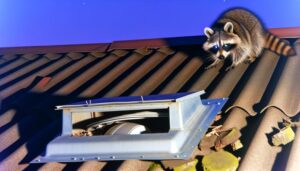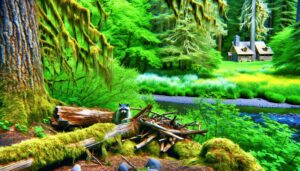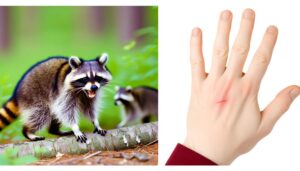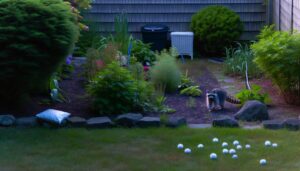3 Humane Steps to Get Rid of Baby Raccoons
Successfully eliminating baby raccoons from your home involves meticulous identification and humane methods. Begin by examining hidden spaces such as lofts and flues for indications like waste and disrupted insulation.
Utilize live trapping or exclusion devices to securely move them to a new location. Seal access points and fit raccoon-resistant caps on flues to deter re-entry.
Guarantee thorough cleaning and restoration of impacted areas to remove smells and pollution. Experts can offer secure and all-encompassing solutions, safeguarding the welfare of both your household and the wildlife.
For detailed steps and precautionary measures, the following guidelines will be highly enlightening.
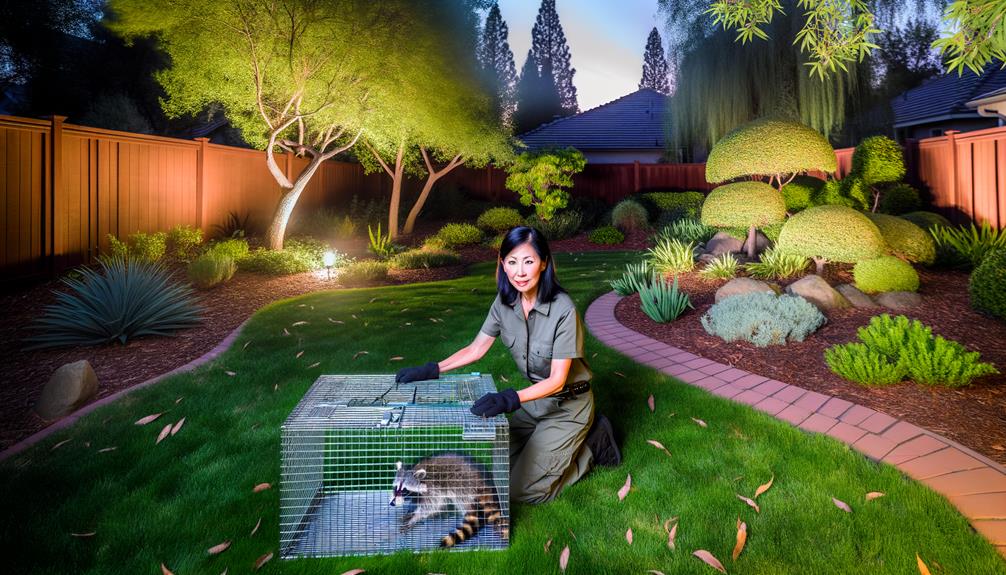
Key Takeaways
- Use humane live trapping techniques to safely capture and relocate baby raccoons.
- Install exclusion devices to allow raccoons to exit but not re-enter the nesting area.
- Secure all entry points and install raccoon-proof caps on chimneys to prevent re-entry.
- Trim tree branches near your roof to eliminate raccoon access points.
- Contact professional wildlife services for safe, ethical removal and relocation of baby raccoons.
Identify the Nesting Area
Identifying the nesting area is a critical first step in safely and effectively removing baby raccoons from your property. Raccoons often choose secluded, dark spaces such as attics, chimneys, or crawl spaces for nesting. To locate these areas, look for signs of raccoon activity, such as droppings, tracks, or disturbed insulation.
Listen for high-pitched sounds, as baby raccoons are vocal and may be heard crying for their mother. Conduct a thorough inspection with appropriate safety gear, including gloves and a mask, to protect against potential zoonotic diseases.
Ensuring proper identification of the nesting site allows for a more humane and strategic removal process, ultimately safeguarding both the raccoons and the property occupants.
Assess the Situation
Once the nesting area is identified, a comprehensive evaluation of the situation is necessary to determine the appropriate course of action for removing the baby raccoons safely and humanely.
Begin by assessing the immediate environment, including access points, potential hazards, and the age and number of the raccoons. This information is essential for devising a tailored removal strategy.
Consider the physical condition of the baby raccoons, as very young or injured animals may require specialized care. Additionally, assess any risks posed to household members or pets.
Documenting these details will help in coordinating with wildlife professionals or local animal control agencies. A thorough assessment ensures that all actions taken prioritize safety, compliance with local regulations, and the well-being of the raccoons.
Humane Removal Methods
Humane removal of baby raccoons involves employing techniques that prioritize their safety and well-being.
Key methods include live trapping techniques, the use of exclusion devices, and engaging professional wildlife services.
Each approach minimizes harm while ensuring effective relocation of the animals.
Live Trapping Techniques
To effectively trap baby raccoons, careful planning and adherence to humane practices are essential to ensure the safety and well-being of the animals.
To start with, choose a live trap of appropriate size, making sure it is clean and in good working order. Position the trap in a calm location where raccoon activity is noticeable, and bait it with enticing foods like fruits or pet food.
Check the trap regularly to reduce stress on the captured animal. Always handle the trapped raccoon with care and wear protective gloves to prevent harm.
Once captured, promptly relocate the baby raccoon to a safer, natural habitat as advised by local wildlife authorities. This method demonstrates our dedication to humane and ethical wildlife management.
Exclusion Devices Usage
Why are exclusion devices a preferred method for the humane removal of baby raccoons from residential areas?
Exclusion devices, such as one-way doors and raccoon eviction fluid, offer a non-invasive and stress-free solution for both the animals and property owners. These devices allow raccoons to exit an area but prevent re-entry, encouraging them to relocate naturally without human contact. This method minimizes the risk of injury to the raccoons and reduces potential damage to property.
Additionally, exclusion devices are designed to be species-specific, ensuring that other wildlife is not inadvertently affected. Employing exclusion devices aligns with ethical wildlife management practices and promotes a harmonious coexistence between humans and raccoons, prioritizing safety and humane treatment.
Professional Wildlife Services
Engaging professional wildlife services guarantees the safe and humane removal of baby raccoons from residential areas. These services leverage expert techniques and specialized equipment to address the issue effectively.
These services prioritize the well-being of both the animals and residents by employing non-lethal methods such as live trapping and relocation. Trained professionals conduct thorough assessments to identify entry points and implement exclusion strategies, ensuring raccoons do not return.
Moreover, they adhere to local wildlife regulations and ethical standards, minimizing stress and harm to the animals. By choosing professional wildlife services, homeowners can rest assured that the baby raccoons are handled with care, and potential health risks are mitigated, fostering a safer and more harmonious living environment.
Prevent Future Intrusions
To prevent future intrusions by baby raccoons, it is important to secure all potential entry points around your property. Begin by inspecting your home's exterior, including eaves, vents, and chimneys, ensuring they are sealed with durable materials.
Install raccoon-proof caps on chimneys and use heavy-gauge wire mesh on vents. Check for gaps under doors and windows, and repair any damaged screens. Additionally, secure garbage cans with tight-fitting lids and avoid leaving pet food outdoors, which can attract raccoons.
Trim tree branches that overhang your roof to eliminate easy access points. Regularly maintain your yard to deter raccoons from nesting. By implementing these measures, you can safeguard your home and support the well-being of your community.
Clean and Repair
Once the baby raccoons have been safely removed, it is important to address any lingering odors and potential entry points to prevent future infestations.
Thoroughly clean the affected areas to eliminate scents that might attract other raccoons.
Additionally, inspect and seal all possible entry points to guarantee your property remains secure from wildlife intrusions.
Remove Raccoon Odors
Eliminating raccoon odors from your property demands a thorough cleaning and repair process to guarantee a safe and hygienic environment. This meticulous approach not only eradicates the unpleasant smell but also prevents potential health risks associated with raccoon presence.
Here are three essential steps:
- Sanitize Affected Areas: Use enzymatic cleaners to break down organic matter and neutralize odors. Ensure all surfaces, including insulation and flooring, are disinfected.
- Replace Contaminated Materials: Remove and substitute any materials, such as insulation, that have been heavily soiled or damaged by raccoon activity.
- Air Purification: Utilize HEPA air purifiers to eliminate lingering airborne contaminants and enhance indoor air quality.
Seal Entry Points
Identifying and sealing entry points is important to prevent raccoons from re-entering your property and to guarantee long-term safety and integrity of the structure. Begin by thoroughly inspecting the exterior, focusing on vulnerable areas such as attics, chimneys, and roof eaves. Use durable materials like metal mesh and weather-resistant sealants to close off gaps and openings. Regular maintenance and timely repairs are essential to uphold these barriers.
| Action | Benefit | Emotional Impact |
|---|---|---|
| Inspect | Prevents re-entry | Peace of mind |
| Seal | Enhances safety | Sense of security |
| Maintain | Prolongs integrity | Confidence in solution |
Seek Professional Help
Engaging the services of a licensed wildlife removal expert is vital for safely and humanely addressing the presence of baby raccoons. These professionals possess the knowledge and tools necessary to handle wildlife encounters without posing risks to the animals or your household.
Here's why consulting an expert is important:
- Safety: Trained professionals guarantee the removal process is conducted without harm to the raccoons or residents.
- Ethical Methods: Experts use compassionate practices, ensuring the baby raccoons are relocated to suitable habitats.
- Preventive Measures: They provide advice and services to prevent future infestations, such as sealing entry points and habitat modification.
Employing professional help safeguards the wellbeing of both your family and the wildlife.
Conclusion
Effectively handling a baby raccoon infestation involves identifying the nesting area, evaluating the situation, employing humane removal methods, preventing future intrusions, and undertaking thorough cleaning and repair.
A common objection may be the perceived complexity of these steps; however, following a structured approach guarantees safety and efficacy.
Engaging professional help when necessary guarantees adherence to wildlife regulations and minimizes harm, ultimately fostering a safe environment for both humans and animals.

